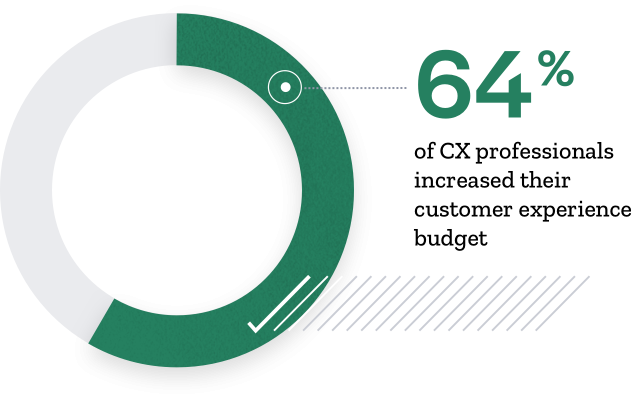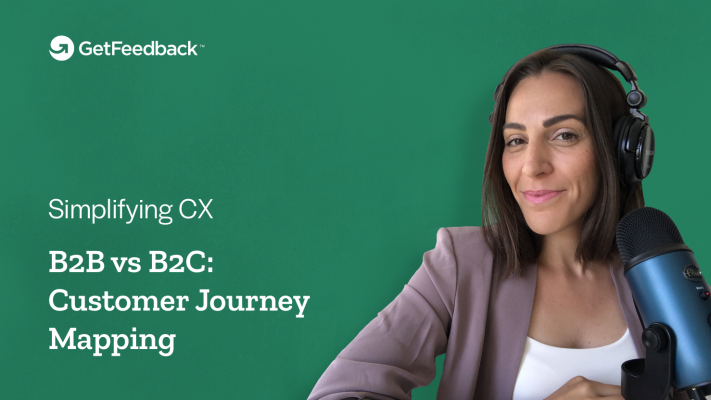What is customer experience?
Customer experience (CX) is how your customers perceive their interactions with your company.
To provide great customer experiences, organizations need to meet or exceed the expectations of their customers during all interactions with their company.

Why is great customer experience important?
Customer experience determines whether your organization succeeds or fails.
Poor customer experience (CX) is costing U.S. companies billions of dollars each year due to avoidable churn. Today’s customers expect a personalized experience that always meets their needs. If they don’t receive it, they’ll most likely move on to another brand.
But if a company consistently meets or exceeds expectations, customers will stick around. They might even view that company as being irreplaceable. And being irreplaceable helps the bottom line. Delivering great customer experiences is no longer an option. However, while 80% of companies believe they deliver “superior experiences,” only 8% of customers agree. There is a significant gap here. Luckily, the answer to why companies struggle to deliver customer satisfaction is simple.
Why brands struggle to deliver great customer experiences
Most companies struggle to meet the expectations of their customers because customer experience is defined by perception, which is often based on emotion and differs from person to person.
Two customers can view the same experience in completely different ways due to many factors that influence their interpretation of events.
Once you understand this, the solution to delivering great CX is simple: focus on building long-term customer relationships.
This means building trust with your customer, understanding their needs, and adapting to nurture that bond. Brands can achieve this with the right customer experience tools and insight that allow you to streamline and automate the personal touch that customers want at scale.
Top challenges CX leaders must overcome
Overcoming the challenge of scaling customers’ perceptions is just the tip of the iceberg when it comes to delivering great customer experiences.
Most CX leaders lack the proper budget and team to support their CX strategy and initiatives. In fact, only 7% claim to have been able to formally prove the ROI of their customer feedback program alone. This isn’t for lack of trying—it’s hard to prove the efficacy of a program if you’re not equipped with the right tools to measure its success.

Another hurdle common among customer experience professionals is the lack of cross-functional collaboration across the organization. This can manifest itself in information silos and often insufficient customer data, misalignment across departments regarding the customer experience strategy, lack of technology infrastructure, and much more.
The root cause of this misalignment is typically the way a company is structured and how it operates, and in most cases can be resolved by adopting a cross-functional CX program model.
Although it may take time, these challenges can be overcome with the right CX strategy and customer experience management program.
The B2B customer experience report
Our research reveals a new outlook on the CX space and how to thrive in it. Here are the top three key imperatives you should explore.

How to launch a CX management program
Customer experience management (CXM) is the process of designing and optimizing customer interactions to meet or exceed customer expectations.
The goal of CXM is to increase customer satisfaction, company advocacy, and customer loyalty, all while cutting costs.
Although customer experience management programs vary by industry and a business’s particular goals, there are four elements that are not negotiable:
- Voice of the Customer (VoC)
- Customer journey map
- CX leadership coalition
- Employee experience (EX)
Voice of the Customer (VoC) program
The Voice of the Customer program is the heartbeat of any customer experience program. It captures, analyzes, and reports on all feedback associated with your brand.
Basically, it gives you real-time insight into your customers’ experiences. From this feedback, you can identify trends and opportunities to act on that will help you deliver great customer experiences.
Customer feedback can be captured via structured and unstructured data. Structured data is collected via customer loyalty metrics that are measured via customer experience surveys. Whereas unstructured data includes feedback from other channels like social media or a phone call between a disgruntled customer and a customer support agent.
There is a whole catalogue of CX metrics, but the three most popular are:
- Net Promoter Score® (NPS®)
- Customer Effort Score (CES)
- Customer Satisfaction Score (CSAT)
These three metrics are measured in a survey format and they’re referred to as structured data tools because you’re proactively using them to retrieve customer feedback.
The Net Promoter Score is a great metric to measure long-term customer satisfaction and loyalty. It’s the big picture metric of customer experience.
The Customer Satisfaction Score is used to measure the customer satisfaction of a specific interaction or event. It’s a short-term satisfaction metric for customer experience.
The Customer Effort Score is used to measure the level of effort that a customer experiences when they interact with your brand. It’s a transactional, short-term metric for customer experience.
While customer experience surveys are key to a successful VoC program, they shouldn’t be your only source of truth. You also need to create listening paths that tap into unstructured feedback.
And all of this customer insight should be centralized into one Voice of the Customer dashboard accessible to all employees. That way you’re supporting the cross-functional alignment of your CX strategy.
Customer journey map
A customer journey map summarizes the key interactions that a customer experiences with your brand.
This map will help you align your experience strategy across your company and identify areas of improvement across all touchpoints.
According to McKinsey & Company, well-designed customer journey maps have the potential to increase customer satisfaction by 20 percent, lift revenue by up to 15 percent, and lower the cost of serving customers by as much as 20 percent.
When engaging with brands, customers expect an effortless transition from one touchpoint to another, whether it be digital channels, in-person, or both. They expect to accomplish what they need in the most convenient way for them, regardless of the channel or device they chose to use.
Customer journey mapping enables companies to identify the weaknesses and opportunities in these key touchpoints in order to deliver a seamless customer experience.

CX leadership coalition
Regardless of your company size, there must be a cross-functional group of leaders assigned the task to ensure your CX program is implemented properly.
In order to be successful, this coalition should represent every major customer experience touchpoint across the customer journey, like department heads, business unit heads, and other leaders deemed essential to successful outcomes.
These are the leaders that believe in the CX program and will advocate for it. They also track, prioritize, and approve customer experience improvement plans provided by various teams and stakeholders.
Employee experience
Employee experience (EX) is the sum of all the interactions that an employee has with their employer during the duration of the employment relationship.
It’s equally important as CX because happy employees cultivate happy customers. To ensure a positive work environment, provide the tools necessary to empower teams to do their job well. This means streamlining customer insight across the organization with dashboards and CRM tools like Salesforce, providing the right technology, and ensuring every employee can confidently talk to your customer experience strategy and program.
Terms under the customer experience umbrella
There can be a lot of confusion around the terms customer experience (CX) and digital experience (DX). Essentially, customer experience is the umbrella term, and digital experience is a subset. So, to meet customer needs and establish brand loyalty, companies need to deliver both great DX and CX in a seamless manner.
While CX includes the entire experience a customer has with a company (offline and online), the digital experience is the sum of all the interactions that a customer has with an organization via digital touchpoints—website, app, mobile, social media, etc. Under customer experience, you’ll find other subsets—like user experience (UX) and user interface (UI)—that if prioritized as part of your CX program, will give your company a significant competitive advantage. Learn more about CX terms and metrics.
Create a culture that cares about customer experience
Collecting and analyzing customer feedback is only one piece of the puzzle: you must take action in real time to make an impact.
The reality is that most companies are lucky to have a designated customer experience leader, let alone a CX team, which is why it’s key that every team member in each department spends their limited time actually taking action toward improving the experience.
But intentional action can only happen if there is a culture that cares about the customer experience. You can cultivate this by ensuring that each team member understands the critical role they play within the customer journey; help them see how their strategic actions influence the success of their department and of the entire company.
To keep up with evolving customer expectations, companies must keep a steady pulse on the voice of the customer across all touchpoints. In doing so, they’ll maximize customer loyalty and improve the bottom line.
The state of CX teams: 5 learnings from our peer survey
We surveyed 180 CX professionals to dig into challenges, opportunities, and the state of customer experience teams.

Excel at customer experience
Get the straightforward answers you need to build world-class CX programs. Visit our resources center for guides, videos, interviews with experts, and everything customer experience.
*Net Promoter, Net Promoter System, Net Promoter Score, NPS and the NPS-related emoticons are registered trademarks of Bain & Company, inc., Fred Reichheld and Satmetrix Systems, Inc.


